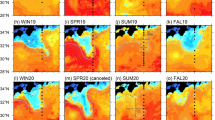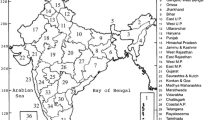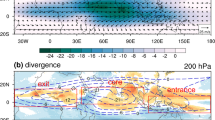Abstract
The upper air RS/RW (Radio Sonde/Radio Wind) observations at Kolkata (22.65N, 88.45E) during pre-monsoon season March–May, 2005–2012 is used to compute some important dynamic/thermodynamic parameters and are analysed in relation to the precipitation associated with the thunderstorms over Kolkata, India. For this purpose, the pre-monsoon thunderstorms are classified as light precipitation (LP), moderate precipitation (MP) and heavy precipitation (HP) thunderstorms based on the magnitude of associated precipitation. Richardson number in non-uniformly saturated (R i *) and saturated atmosphere (R i ); vertical shear of horizontal wind in 0–3, 0–6 and 3–7 km atmospheric layers; energy-helicity index (EHI) and vorticity generation parameter (VGP) are considered for the analysis. The instability measured in terms of Richardson number in non-uniformly saturated atmosphere (\(R_{i}^{\mathrm {\ast } })\) well indicate the occurrence of thunderstorms about 2 hours in advance. Moderate vertical wind shear in lower troposphere (0–3 km) and weak shear in middle troposphere (3–7 km) leads to heavy precipitation thunderstorms. The wind shear in 3–7 km atmospheric layers, EHI and VGP are good predictors of precipitation associated with thunderstorm. Lower tropospheric wind shear and Richardson number is a poor discriminator of the three classified thunderstorms.











Similar content being viewed by others
References
Asai T 1964 Cumulus convection in the atmosphere with vertical wind shear: Numerical experiment; J. Meteorol. Soc. Japan 42 245–259.
Cao J, Zhou Y and Gao S 2011 A brief report of graphic explanations for generalized potential temperature in the non-uniformly saturated atmosphere; Atmos. Ocean. Sci. Lett. 4 162–167.
Chatterjee R N, Prakash P and Singh G 1995 Frequency of thunderstorm occurrence and their height distribution in different regions in India – A radar study Vayu Mandal; J. Indian Meteorol. Soc. 25 41–46.
Chaudhari H S, Sawaisarje G K, Ranalkar M R and Sen P N 2010 Thunderstorms over a tropical Indian station, Minicoy: Role of vertical wind shear; J. Earth Syst. Sci. 119 603–615.
Dalal S, Lohar D, Sarkar S, Sadhukhan I and Debnath G C 2012 Organizational modes of squall –type mesoscale convective system during pre-monsoon season over eastern India; Atmos. Res. 106 120–138.
Davies J M 1993 Hourly helicity, instability, and EHI in forecasting super-cell tornadoes; Preprints, 17th Conference on Severe Local Storms, St. Louis, MO, American Meteorological Soc., pp. 107–111.
Dhawan V B, Tyagi A and Bansal M C 2008 Forecasting of thunderstorms in pre-monsoon season over northwest India; Mausam 59(4) 433–444.
Fankhauser J C 1971 Thunderstorm environment interactions determined from aircraft and radar observations; Mon. Wea. Rev. 99 171–192.
Fankhauser J C 1988 Estimates of precipitation efficiency from field measurements in CCOPE; Mon. Wea. Rev. 116 663–684.
Joseph P V and co-authors 2005 Severe thunderstorms – observations and regional modeling (STORM) programme; Science Plan.
Gao S and Cao J 2007 Physical basis of generalized potential temperature and its application to cyclone tracks in non-uniformly saturated atmosphere; J. Geophys. Res. 112 D18101, doi: 10.1029/2007JD008701.
Ghosh A, Lohar D and Das J 2008 Initiation of Nor’wester in relation to mid-upper and low level water vapor patterns on METEOSAT-5 images; Atmos. Res. 87 116–135.
Goa S, Wang X and Zhou Y 2004 Generation of generalized moist potential vorticity in a frictionless and moist adiabatic flow; Geophys. Res. Lett. 31 L12113.
Hart J A and Korotky W 1991 The SHARP workstation v1.50 user guide; National Weather Service, NOAA, US Dept. of Commerce, 30 [available from NWS Eastern Region Headquarters, 630 Johnson Ave, Bohemia, NY 11716].
Koteswaram P and De A C 1959 Study of premonsoon thunderstorms over GWB by radar; Indian J. Meteorol. Geophys. 10 275–282.
Koteswaram P and Srinivasan V 1958 Thunderstorms over Gangetic West Bengal in the premonsoon season and the synoptic factors favorable for their formation; Indian J. Meteorol. Geophys. 9 301–312.
Kunz M 2007 The skill of convective parameters and indices to predict isolated and severe thunderstorms; Natural Hazards Earth Syst. Sci. 7 327–342.
Lohar D and Pal B 1995 The effect of irrigation on pre-monsoon precipitation over south West Bengal India; J. Climate 8 2567–2570.
Malkus J S 1952 The slopes of cumulus clouds in relation to external wind shear; Quart. J. Roy. Meteorol. Soc. 78 530–542.
Mohanty U C et al. 2006 Weather summary during pilot experiment of severe thunderstorms – observations and regional modeling (STORM) programme (13 April to 31 May 2006); Department of Science & Technology, Government of India, Technology Bhawan, New Delhi.
Mohanty U C et al. 2007 Weather summary during pilot experiment of severe thunderstorms – observations and regional modeling (STORM) programme (13 April to 31 May 2007); Department of Science & Technology, Government of India, Technology Bhawan, New Delhi.
Mukhopadhyay P, Singh H A K and Singh S S 2005 Two severe Nor’westers in April 2003 over Kolkata using Doppler radar observations and satellite imagery; Weather 60 343–353.
Newton C W and Newton H R 1959 Dynamic interactions between large convective clouds and environment with vertical shear; J. Meteorol. 16 483–496.
Normand C W B 1921 Wet-bulb temperature and thermodynamics of air; India Meteorological Memoirs, 23, Part I.
Rajeevan M, Madhulatha A, Rajasekhar M, Jyoti Bhate, Amit Kesarkar and Appa Rao B V 2012 Development of a perfect prognosis probabilistic model for prediction of lightning over south-east India; J. Earth Syst. Sci. 121(2): 355–371.
Rasmussen E N and Blanchard D O 1998 A baseline climatology of sounding-derived supercell and tornado forecast parameters; Weather Forecast. 13 1148–1164.
Ravi N, Mohanty U C, Madan O P and Paliwal R K 1999 Forecasting of thunderstorms in the pre-monsoon season at Delhi; Meteorol. Appl. 6 29–38.
Robe F R and Emanuel K A 2001 The effect of vertical wind shear on radiative–convective equilibrium states; J. Atmos. Sci. 58 1427–1445.
Sadhukhan I and De U K 1998 Premonsoon convective developments over Gangetic West Bengal during 1980–89; Indian J. Radio Space Phys. 27 102–109.
Sadhukhan I, Lohar D and Pal D K 2000 Pre-monsoon season rainfall variability over Gangetic West Bengal and its neighborhood; India Int. J. Climatol. 20 1485–1493.
Savvidou K, Orphanou A, Charalambous D, Lingis P and Michaelides S 2010 A statistical analysis of sounding derived indices and parameters for extreme and non-extreme thunderstorm events over Cyprus; Adv. Geosci. 23 79–85.
Schultz P 1989 Relationships of several stability indices to convective weather events in Northeast Colorado; Wea. Forecasting 4 73–80.
Shou S, Li S and Yao X et al. 2003 Mesoscale Meteorology; China Meteorological Press, Beijing. 72p (in Chinese).
Sohoni V V 1928 Thunderstorms of Calcutta (1900–1926); India Meteorological Department Scientific Note 1(3) 25–36.
Srinivasan V K, Ramamuthy Y R and Nene 1973 Summer– Nor’westers and Andhis and large scale convective activit`y over peninsula and central parts of the country; India Meteorological Department, Forecasting Manual Part III.
Tyagi B, Naresh Krishna V and Satyanarayana A N V 2011 Study of thermodynamic indices in forecasting pre-monsoon thunderstorms over Kolkata during STORM pilot phase 2006–2008; Natural Hazards 56 681–698.
Weisman M L and Klemp J B 1982 The dependence of numerically simulated convective storms on vertical shear and buoyancy; Mon. Wea. Rev. 110 504–520.
Weston K J 1972 The dryline of northern India and its role in cumulonimbus convection; Quart. J. Roy. Meteorol. Soc. 98 519–531.
Yang S, Gao S and Wang D 2007 A study of Richardson number and instability in moist saturated flow; Chinese J. Geophys. 50 365–375.
Zhao Y, Cui X and Gao S 2010 Richardson number in a moist atmosphere and its application in the analysis of heavy rainfall events; Acta Meteorologica Sinica 24 95–103.
Acknowledgements
The Department of Atmospheric Science, University of Wyoming is acknowledged for the Radiosonde data over Kolkata during the pre-monsoon months of 2005–2012. Weather underground is acknowledged for providing the information regarding the occurrence of thunderstorms and the rainfall datasets. Mr D Pradhan, DDGM, RMC Kolkata is acknowledged for providing the radar imageries over the study area. Department of Science and Technology, Government of India is sincerely acknowledged for providing financial support to conduct the research.
Author information
Authors and Affiliations
Corresponding author
Rights and permissions
About this article
Cite this article
Nayak, H.P., Mandal, M. Analysis of stability parameters in relation to precipitation associated with pre-monsoon thunderstorms over Kolkata, India. J Earth Syst Sci 123, 689–703 (2014). https://doi.org/10.1007/s12040-014-0426-z
Received:
Revised:
Accepted:
Published:
Issue Date:
DOI: https://doi.org/10.1007/s12040-014-0426-z




